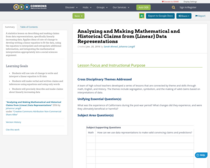Learning Domain: Algebra: Creating Equations
Standard: Create equations that describe numbers or relationship. Create equations in two or more variables to represent relationships between quantities; graph equations on coordinate axes with labels and scales.*
Degree of Alignment:
Not Rated
(0 users)
Learning Domain: Functions: Interpreting Functions
Standard: For a function that models a relationship between two quantities, interpret key features of graphs and tables in terms of the quantities, and sketch graphs showing key features given a verbal description of the relationship. Key features include: intercepts; intervals where the function is increasing, decreasing, positive, or negative; relative maximums and minimums; symmetries; end behavior; and periodicity.*
Degree of Alignment:
Not Rated
(0 users)
Learning Domain: Number and Quantity: Quantities
Standard: Use units as a way to understand problems and to guide the solution of multi-step problems; choose and interpret units consistently in formulas; choose and interpret the scale and the origin in graphs and data displays.*
Degree of Alignment:
Not Rated
(0 users)
Learning Domain: Statistics and Probability: Interpreting Categorical and Quantitative Data
Standard: Fit a function to the data; use functions fitted to data to solve problems in the context of the data. Use given functions or choose a function suggested by the context. Emphasize linear, quadratic, and exponential models.*
Degree of Alignment:
Not Rated
(0 users)
Learning Domain: Statistics and Probability: Interpreting Categorical and Quantitative Data
Standard: Interpret the slope (rate of change) and the intercept (constant term) of a linear model in the context of the data.*
Degree of Alignment:
Not Rated
(0 users)
Learning Domain: Mathematical Practices
Standard: Construct viable arguments and critique the reasoning of others. Mathematically proficient students understand and use stated assumptions, definitions, and previously established results in constructing arguments. They make conjectures and build a logical progression of statements to explore the truth of their conjectures. They are able to analyze situations by breaking them into cases, and can recognize and use counterexamples. They justify their conclusions, communicate them to others, and respond to the arguments of others. They reason inductively about data, making plausible arguments that take into account the context from which the data arose. Mathematically proficient students are also able to compare the effectiveness of two plausible arguments, distinguish correct logic or reasoning from that which is flawed, and"Óif there is a flaw in an argument"Óexplain what it is. Elementary students can construct arguments using concrete referents such as objects, drawings, diagrams, and actions. Such arguments can make sense and be correct, even though they are not generalized or made formal until later grades. Later, students learn to determine domains to which an argument applies. Students at all grades can listen or read the arguments of others, decide whether they make sense, and ask useful questions to clarify or improve the arguments.
Degree of Alignment:
Not Rated
(0 users)
Cluster: Reason quantitatively and use units to solve problems
Standard: Use units as a way to understand problems and to guide the solution of multi-step problems; choose and interpret units consistently in formulas; choose and interpret the scale and the origin in graphs and data displays.*
Degree of Alignment:
Not Rated
(0 users)
Cluster: Create equations that describe numbers or relationship
Standard: Create equations that describe numbers or relationship. Create equations in two or more variables to represent relationships between quantities; graph equations on coordinate axes with labels and scales.*
Degree of Alignment:
Not Rated
(0 users)
Cluster: Interpret functions that arise in applications in terms of the context
Standard: For a function that models a relationship between two quantities, interpret key features of graphs and tables in terms of the quantities, and sketch graphs showing key features given a verbal description of the relationship. Key features include: intercepts; intervals where the function is increasing, decreasing, positive, or negative; relative maximums and minimums; symmetries; end behavior; and periodicity.*
Degree of Alignment:
Not Rated
(0 users)
Cluster: Summarize, represent, and interpret data on two categorical and quantitative variables
Standard: Fit a function to the data; use functions fitted to data to solve problems in the context of the data. Use given functions or choose a function suggested by the context. Emphasize linear, quadratic, and exponential models.*
Degree of Alignment:
Not Rated
(0 users)
Cluster: Interpret linear models
Standard: Interpret the slope (rate of change) and the intercept (constant term) of a linear model in the context of the data.*
Degree of Alignment:
Not Rated
(0 users)
Cluster: Mathematical practices
Standard: Construct viable arguments and critique the reasoning of others. Mathematically proficient students understand and use stated assumptions, definitions, and previously established results in constructing arguments. They make conjectures and build a logical progression of statements to explore the truth of their conjectures. They are able to analyze situations by breaking them into cases, and can recognize and use counterexamples. They justify their conclusions, communicate them to others, and respond to the arguments of others. They reason inductively about data, making plausible arguments that take into account the context from which the data arose. Mathematically proficient students are also able to compare the effectiveness of two plausible arguments, distinguish correct logic or reasoning from that which is flawed, and—if there is a flaw in an argument—explain what it is. Elementary students can construct arguments using concrete referents such as objects, drawings, diagrams, and actions. Such arguments can make sense and be correct, even though they are not generalized or made formal until later grades. Later, students learn to determine domains to which an argument applies. Students at all grades can listen or read the arguments of others, decide whether they make sense, and ask useful questions to clarify or improve the arguments.
Degree of Alignment:
Not Rated
(0 users)



Comments